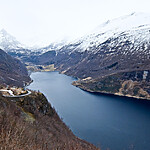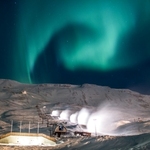Mark Nicholls Guide to Styria may offer some of the best skiing in the Alps, but also showcases a refreshingly tasty aspect to a winter break in Austria.
It’s where ‘crunch, crunch, crunch’ becomes ‘munch, munch, munch’.
From the familiar sound of boots and snowshoes breaking into crisp snow to the sating of healthy appetites, there’s a delicious and direct link between alpine exercise and gourmet delights in Austria’s snowy terrain.
It is part of a growing trend in ski resorts; the balance between activities away from the slopes, coupled with high quality food that has a clear provenance and connection with the region in which it is consumed.
In this case, we are in Styria – or Steiermark as Austria’s second largest state is known – and the winter landscape of Schladming-Dachstein.
A renowned ski area in the colder months, visitors are also discovering there’s much more on offer for those who want a slightly different take on a winter holiday in the Alps.
And culinary delights are high on the agenda.
Celebrity chefs
I spent a few days in Styria and joined a group with a focus away from skiing, first taking an atmospheric torchlit walk on a chilly evening and the next day strapping on snowshoes for a morning hike where the winter landscape was revealed in all its glory.
As you wander along well-signed routes, small restaurants and mountain huts pop up along the way.
And you soon discover that the Austrian cuisine in these cosy establishments is full of flavour – ranging from traditional and instantly recognisable dishes to innovative new tastes on menus that are designed in tandem with celebrity chefs.

The 5km snowshoe route began above Schladming, which sits at an altitude of 745m.
Setting off from Hinkebrücke, the route meandered through forest and then across open fields of fresh snow, criss-crossing the icy waters of the Untertalbach.
Beneath the snow, later in the year, the terrain would become fertile pasture for livestock with the hay stalls visible as landmarks along the way. But on this day, it was blank white canvas.
Tasty menus
Johanna Koubek, who led the snowshoe walk, explained that there are numerous trails across the Schladming area for snowshoers or winter hikers of differing length and difficulty, though most are easy to moderate and take 2-5 hours.
Part of the route also ran alongside the popular Kristalliope trail with cross-country skiers sliding past in the twin tracks.
With several stops to admire the breathtaking views, we eventually arrived at the Sondl-Alm hutte for a timely lunch.


With its atmospheric and cosy wood-panelled interior and a stove heating the saloon, we opened a tasty menu of dishes that were both delicious and wholesome.
As you may expect, classics such as Wienerschnitzel (€15), goulash suppe (€7) and Kaiserschmarrn for dessert were staples but there was an added dimension to the food on offer at Sondl-Alm, which is participating in the Almkulinarik (Alpine cuisine) concept.
This is where leading chefs work with huts across the Schladming area and wider state of Styria to create specific and tailored dishes.
Popular concept
It is a concept that has traction across Austria and you can expect a similar approach in neighbouring SalzburgerLand, or in the Tirolean foodie capital of Ischgl.
For Styria, award-winning chef Richard Rauch has masterminded the menus, working with the huts to create dishes that match the ambience and location of a hostelry and tap into fresh local produce.
The dish at Sondl-Alm is the delicious Hüttengröstl (€13.80) with potato, onions, cheese, bacon, mushrooms, fried egg and a paprika cream. It was a tasty treat after the morning’s hike
An alternative, and equally tempting, was the Uberbackene Kaspressknodel (cheese dumpling) at €14.60.

A total of 16 huts in the Schladming-Dachstein region are participating in the Almkulinarik culinary experience underlining the attraction of a food offer in Austria that is traditional and wholesome, but also innovative, interesting, high quality and great value.
World Championships
Of course, skiing is never far from thoughts in this part of Austria and Schladming is famed for hosting the FIS Alpine World Ski Championships in 1982 and 2013 and other major races, passing that mantle on to nearby Saalbach across the border in SalzburgerLand for the 2025 event during early February.
The 4-Mountain ski area of Schladming includes Hauser Kaibling, Planai, Reiteralm and Hochwurzen with 230km of piste, 77 lifts and 100 ski huts.

There are also 300km of winter walking paths, 430 km of cross-country skiing trails, and nine toboggan runs.
And within this, is the art of ‘refuelling’ with tasty cuisine.
Other restaurants on the mountain that are also worth a stop at include Die Landalm (roast beef in red wine sauce with dumplings and red cabbage is delicious at €25.90) or the Waldschenke where the pork ribs cost €18.50, venison goulash is €20.50 and Wienerschnitzel is €16.90. For drinks, an Aperol spritzer is typically €7-8, a large beer is €6.
Tasting sessions
If your taste buds are suitably aroused by Styrian fayre, Heimatgold near Schladming’s Planai ski centre sells around 1,000 different food and drink products and holds tasting sessions that cost €20-50 per person, depending on the selected menu/products.
The shop’s produce buyer Sonja Royer explained: “The products are mostly from Styria or from Salzburg. We pick them carefully and have direct contact with the local farmers.
 ”
”
Sausage and salami hung from a tempting rack on the table with camembert and liver pate, cheese with garlic, 18-month cured ham, butter and local bread, ready for us to sample.
All were paired with wines: a rose frizzante from Styria and a white Muskateller.
Pine forests
The activities, and emphasis on cuisine, are an inevitability of the changing landscape of winter holidays as snow becomes a scarcer commodity and more guests endeavour to seek out new dishes and local flavours as part of their break.
Other activities can include fat-biking across the snow, paragliding, even a horse-drawn sleigh-ride to a mountain restaurant.
While that approach continues into the summer where the visitor split in Schladming-Dachstein is now 50-50 with winter, the romance of exploring the snowy landscape remains.

There’s little to compare to a snowshoe hike through pine forests with branches hanging low with fresh snow, breathing in the crisp clean air, or crossing an icy stream.
In this alpine corner of Austria, the crunch seamlessly turns into the munch.
Tell Me More About A Winter Break In Styria
Getting to Styria: Regular flights from the UK to Salzburg or Munich and taxi transfer.
For more information on the region, visit: Tourismusverband Schladming-Dachstein or Discover Styria
Where to stay: Mark Nicholls stayed at the four-star Hotel Pichlmayrgut just outside Schladming. The expansive golden yellow building cascades down the slope with pools and spas, gym, tennis and squash courts, restaurants and lovely rooms with a regular ski shuttle to the Reiteralm lifts. Typical four-night stay in late March is €1164 for a standard double room.






